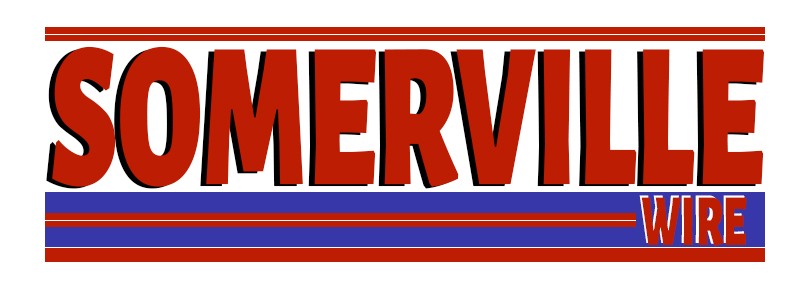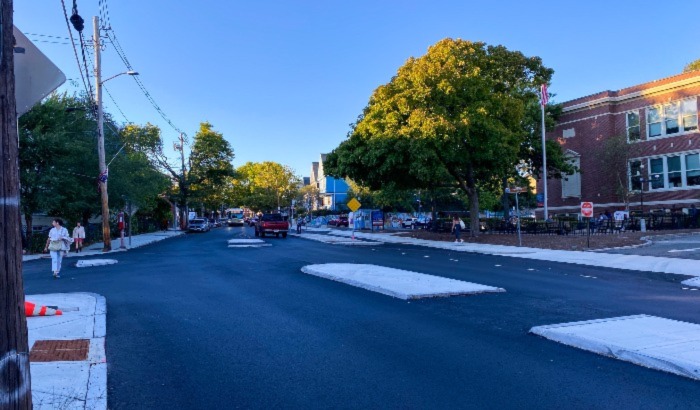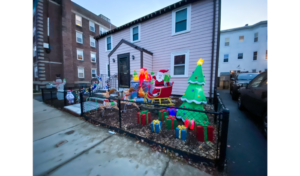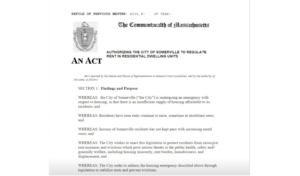Proposed street redesign would bring protected bike lanes to Davis Square and beyond
(Somerville Wire) – Led by Mayor Katjana Ballantyne, the City is proposing to install protected bicycle lanes on Holland Street between Davis and Teele Squares. The proposal brought forth passionate comments at a virtual meeting of the Traffic Commission last Wednesday, Sept. 21.
“We are here to listen to you and to hear your comments,” Acting Commissioner of Public Works Jill Lathan, who chairs the Traffic Commission, told the virtual attendees. Staff members assured participants that they would carefully consider all the comments they received during the meeting as well as written opinions after the meeting.
Ballantyne introduced the proposal by referencing recent deaths of pedestrians and cyclists.
“One of the most important responsibilities in my position as mayor is to protect public safety,” she said. “Since early 2019, six Somerville residents have been killed in traffic crashes in our city. … Each of these tragedies requires empathy for the victim’s family, first and foremost. But as a community, we have the responsibility to prevent crashes from occurring in the first place. We must have city streets which are safe for all users.”
In the past few years, Ballantyne said, “our community has done the hard work to make our streets safer.” She cited new speed bumps, raised crosswalks, refuge islands for pedestrians, and improved traffic signals, signage, and pavement markings.
“And there is more to do. And after the crash that killed Stephen Conley [last month on Broadway], it’s clear we must take action,” she said.
Protected bike lanes are “the safest for all users—bikers, pedestrians, and drivers,” she said. “Because of this safety benefit for all users, I’m committed to delivering protected bike lanes in every Somerville neighborhood.”
“In Somerville, we are committed to supporting the health of all our residents, human and non-human alike.” – Mayor Katjana Ballantyne
Ballantyne called Holland Street “the best location” for protected bike lanes. “Holland Street is one of Somerville’s most important streets for pedestrians and bikers. We have so many key destinations that people want to access .Our unique businesses, senior center, schools, our bus stops, and subway stop. Hundreds of people travel on Holland Street each day. We’ve already taken important steps, first to build concrete pedestrian islands and curb extensions. But I feel strongly that this first step was not enough.”
The mayor added: “Somerville has been planning for growth for a couple of decades now. I was an activist that was working for adding housing, adding commercial development, and adding jobs. You see it all happening around you now. This will mean that there are more users on our streets. Therefore, we have to do everything we can now to make sure that things are safe.”
Following the mayor, Brad Rawson, director of the Mobility Division, gave a presentation on the proposal, emphasizing that his staff members were guided by established City policies.
“The new proposal would comply with Somerville’s adopted citywide safety plan, which is known as our Vision Zero action plan. It would comply with Somerville’s adopted Complete Streets ordinance. It would comply with Somerville’s overall community plan, which is known as SomerVision 2040. And it would comply with Somerville’s adopted climate action plan, which is known as Somerville Climate Forward,” he explained.
Rawson said the new plan reduces on-street parking but increases off-street parking. Tufts University has made a surface parking lot available to the general public at the corner of Holland Street and Cameron Avenue, with fees to be paid either through a mobile app or kiosks on site. Some spaces will also be available in the City’s Transportation Administration Building in Teele Square. The parking lot at Buena Vista Road opposite Wallace Street is often not full, he said, and real-time arrival signage has been installed to “provide motorists and users with live information to reduce frustration and circling behavior.”
In addition, the City recently permitted a new public garage to be constructed in Davis Square at the corner of Elm and Grove. “That will be approximately 75 public parking spaces available a couple of years from now when the construction is completed,” Rawson said.
The proposal calls for eliminating parking on the south side of Holland Street. The north side of the street would have a mix of meters, commercial loading zones, and overnight resident parking. Parking spaces would be located seven feet from the curb, with the westbound protected bike lane against the curb.
The plan would get rid of all 62 of the on-street parking spots that are currently two-hour maximum except by permit. Adding metered parking during the daytime would generate regular turnover of the spaces. The parking would be resident-only overnight.
Rawson said the plan would still allow outdoor dining parklets in some of the parking spaces on the north side of the road, and he specifically mentioned PJ Ryan’s, a pub in Teele Square whose owner has been publicly critical of the proposed parking changes.
“We want to make sure that outdoor dining parklets like the one at PJ Ryan’s can continue. In this scenario, the seasonal outdoor dining would remain at the curbside, and the bike lane would taper around it during the dining season. In the wintertime, the parklet would be removed and the bike lane would be placed on the curbside. Other small businesses would have the ability to apply for parklets, consistent with citywide policy,” Rawson said.
He also noted the safety benefits of the pedestrian-focused curb extensions that have already been constructed, as well as new raised crosswalks that are already scheduled to be constructed in the coming weeks across Holland Street.
Changes to the eastern end of Holland Street, from Buena Vista Road to the central intersection of College Avenue and Dover Street, have already been approved and are not part of this new proposal. A large loading zone has been permitted and is being installed from Buena Vista to Winter Street on the south side of Holland Street.
“For 21 hours a day, that will be a live loading zone for passenger and commercial pickup and drop-off activities. And then for three hours during the peak hours of the morning, it’ll be an extension of the bus lane to make sure MBTA buses can transit the space quickly and efficiently,” Rawson explained, adding that the City has installed new loading zones and parking meters on several side streets, and would also like to add more handicapped-accessible spaces.
“Our staff will work with local residents and business owners to accommodate as many requests as possible,” he said. “This is an iterative process.”
After the presentation, for the next two hours, dozens of residents and business owners, plus a few residents of neighboring municipalities, offered their comments. Most commenters expressed support for the proposal. Almost all of the positive commenters said they were bicyclists, although many of them specified that they also drive cars and walk in the area. They all said the changes would make it easier for them to get to Davis and/or Teele on a bike.
John Marc Imbrescia, who lives on Ossipee Road near Powder House Boulevard, said he’s very concerned about the plan “as someone who’s lived through multiple pedestrian deaths in Powder House and on Broadway. I’m a car owner. I’m a cyclist. I’m a homeowner. I’ve lived here for seven years now. I bike nearly every day through Teele Square down Holland, through Davis, and I’m in full support of this plan, and I wish that it could have come sooner.”
Imbrescia added, “If the city can get more people to feel comfortable and confident and safe while they’re cycling, we can take more cars off the road. And a reduction in parking won’t seem as big a deal for people because there will be more available spots because more people will have arrived through alternative means.”
Mark Chase, an urban planner who teaches transportation planning at Tufts, suggested that the city should collect in-depth data on the outcomes of the changes after they are made.
“If we do this, and hopefully we will, we can see whether more people are walking, biking, and taking transit, whether we’re seeing less vehicle crashes. Are households able to reduce their dependence on cars? Are households saving money through owning one less car? How happy are abutters, business owners, and patrons? Can business sales tax or tax data be collected to see what net sales are across the whole business community impacted by the project? And how happy are drivers, transit riders, bicyclists, and walkers? This is a subjective question, but something that’s worth asking. Are we seeing less greenhouse gasses being emitted? Are we seeing better public health outcomes as people become more active? Are we seeing more access for low-income people to get to their jobs? Are people feeling more connected to the people and places they care about?”
Ariel White, a Hinckley Street resident, said the protected bike lanes would make her more likely to visit businesses in Teele Square. She also pointed out that “the set of people who have the time and the interest to turn up to a Traffic Commission meeting on a Wednesday night to give public comment is really not going to be a particularly representative sample of the people of Somerville.” But in the last election, she said, “the people of Somerville chose a mayor and a set of city councilors who had come out really strongly in support of safe streets plans like this. So, while you hear from your most passionate voices in Somerville here tonight, which is wonderful, please remember that these voices are also backed by the votes of thousands more people who have already made their support for these kinds of safety measures clear at the ballot box.”
The commenters who were opposed to the project said they expected the new plan to have negative economic impacts on the local merchants. Some said the new street design would hinder people who have limited mobility.
Former Alderman Jack Connolly, a longtime resident and business owner, said the City failed to get adequate input from diverse constituents.
“I’m a huge supporter of public safety, but I’m a bigger supporter of public process,” he said. “I hope this is the beginning of a process that will include a public hearing where people, the thousands of people that I’m speaking for right now, who cannot ride a bicycle, who have mobility issues and who cannot move about as freely as a lot of people who cycle. There happen to be many thousands in the city. We need to look at those.”
Connolly concluded: “Nobody here disagrees with public safety, not one bit…. But let’s make sure we hear from those people, like the small businesses on Holland Street, who have not been heard from. This plan changed radically in the last 30 days. People have had little time to react. Give them some more time.”
Stephen Mackey, president of the Somerville Chamber of Commerce, agreed with Connolly that the City should have a public hearing on the issue before making such major decisions. The public was only given three business days’ notice before the meeting, he said.
“I think the experience tonight has been wonderful,” said Mackey, who was one of the last speakers. “Whatever my view, I think every single person tonight was civil, articulate, and frankly, moving, in terms of their interest in this, and their sincerity. So I don’t think the Traffic Commission would regret this idea of having a public hearing. And I think as we go forward, whatever you do about Holland Street, you have 20-plus miles of unprotected bike lanes. You need to figure out how you’re gonna approach those. I think you should approach those with public hearings, [with] two weeks’ notice.”
Documents related to the draft safety proposal for Holland Street are located on the City’s website: https://voice.somervillema.gov/4794/widgets/16025/documents/35127. Written comments about the proposal can be sent by email to the Traffic Commission at trafficcommission@somervillema.gov (cc: transportation@somervillema.gov) or by mail to: Parking Department, ATTN: Traffic Commission, 133 Holland St, Somerville, MA 02144. The commission will reconvene for a vote in the coming weeks.
Photo credit: Pedestrian crossing at the corner of Holland St. and Cameron Ave. Photo by Jason Pramas. Copyright 2022 Jason Pramas.
Linda Pinkow is a reporter for the Somerville Wire. She is also a development consultant for the Boston Institute for Nonprofit Journalism.





